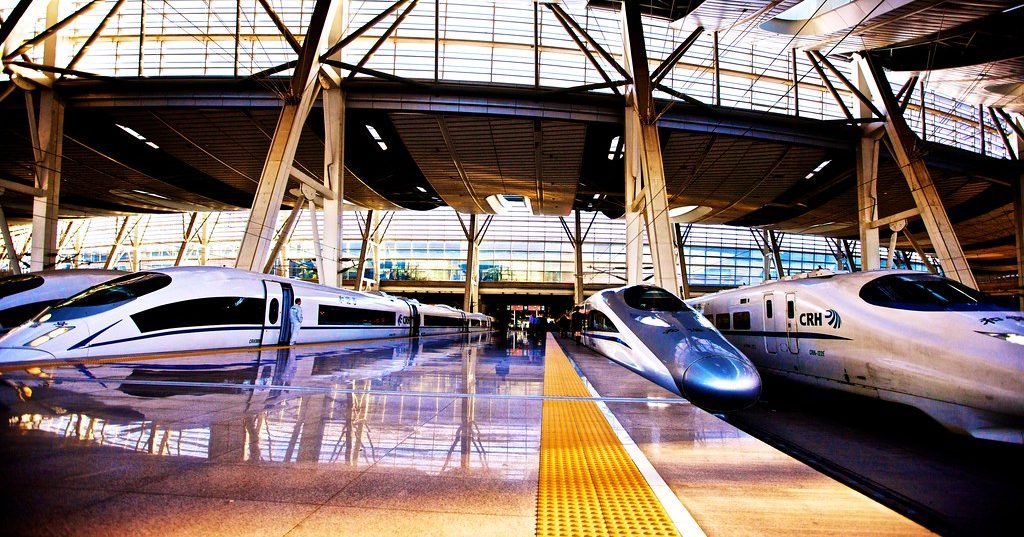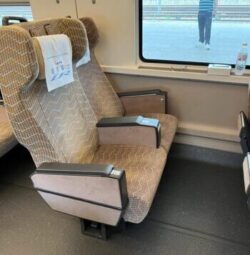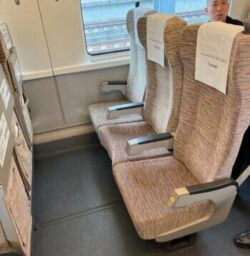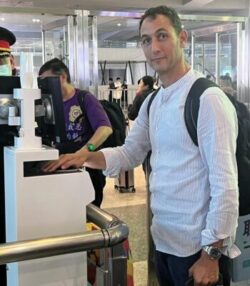
China invested about US$900bn from 2008 – 2023 in a national high speed rail network of over 26,000 miles (40,000km), about 13 times the length of Japan or France’s network. Like theirs, trains are designed to run at between 120 – 220mph. In 2021, during the Covid period, this mammoth infrastructural investment brought in US$104 billion in revenues, representing (according to the Paulson Institute and World Bank) a return of about 7% in lower-carbon generating interconnectivity.
Climate-conscious travelers will wish to use this network as much as possible in their journeys. Other people might wish to learn more about what travel in these trains is like and about the overall value proposition before incorporating certain train routes into their China travel.
Beijing to Xi’an – Time Comparison
For a first-time traveler to China, the obvious route to do by rail is that between Beijing and Xi’an. The fastest high-speed train between Beijing and Xi’an takes 4 hours and 11 minutes. The train arrives and departs exactly on time and the likelihood of a delay is improbable.
Travel time to West Station in Beijing is about 20 minutes from the centre of Beijing, defined as Tiananmen Square, but many travelers will be residing in Chaoyang district on Beijing’s eastern side and so can expect this journey to take 40 minutes or more. On the day of my trial, I was running late and so crossed the station and boarded the train within ten minutes. However, most people will wish to allow at least 30 minutes and tour operators may well wish to pre-book porters, as otherwise clients will be pushing their bags for long distances from their vehicle through the station and onto the train itself.
At the other end, it took me 1 hour to travel by car from Xi’an North Station to the Ritz Carlton in the south of the city. Although this is geographically considerably closer than from Xi’an airport, inner-city traffic resulted in it taking just as long. Door to door the total journey time from Beijing to Xi’an on the fastest train is therefore 6 hours and 20 minutes.
If you travel by plane, it will take you about the same transit time to go by car to T2 or T3 at Beijing International airport about 1 hour in advance. Aviation companies allow 2 hours and 15 minutes but flight time is only 1.5 hours. Assuming airport arrival 1 hour before departure and then 30 minutes at the other end to pick up your bags, then the total journey time by plane is 5.5 hours, or about 50 minutes quicker. That said, whereas train travel happens to the minute, plane travel is subject to more frequent delays.
Comparing Price, Carbon And Other Factors
The three classes of train travel in descending order are Business, First and Second. (Yes, Business is above First.) These are described in more detail in a special section below. Business is about double the price of First Class and more than triple that of Second Class. Traveling in Business by train is priced to be equivalent to the plane. By comparison “First Class” on the train, which offers much more space and comfort than Economy on the plane, is about 20% cheaper than the plane. Second class on the train, which is still slightly roomier than Economy on a plane is about half the price of the plane.
Therefore, if you are a business person prioritizing speed above all else, then traveling by plane wins. However, if the business person has some project work to do, it will be easier to complete it on the train where s/he spends more time in one place, and so it is arguable that even though the transit takes one hour longer by train, it makes for better use of time.
Climate conscious travelers will be aware that train travel results in about 14 – 16 times less emission than plane travel. Families and older travelers should be aware that the total walking distance in train stations is not dissimilar to what you encounter in airports, though the security is less bothersome.
A last consideration for the tourist is that other than skyscapes and clouds, there is little to see out of the window over the course of a plane journey. By contrast, the view from the train is fascinating, affording real insight into the huge progress that the countryside has made over the last 15 years as a result of China’s Poverty Alleviation campaign.
Which Route Makes Sense
A plane travels over 2.5 times faster than the quickest train, and we see that with a train time of 4 hours, the plane already provides a speedier transit, even if the train might overall offer a better value proposition for some people. Routes such as Beijing – Xi’an (4 hours and 11 minutes) Beijing – Shanghai (4 hours and 29 minutes) and Guilin – Hong Kong (4 hours and 7 minutes) might be considered for rail travel. A no-brainer at 1.5 hours would be Hangzhou – Huangshan. Other shorter journeys of an hour or less where the rail network should be considered are those such as Shanghai – Hangzhou, Shanghai – Suzhou or Beijing – Tianjin. I would meanwhile suggest that train routes of more than 4 hours, such as Guilin – Xi’an at about 10 hours, are not going to prove popular when a flight of 2 hours is available.
On The Train – Comparison of Business, First and Second Class
Business Class

Business class consists of 4 – 6 comfortable, electronically-adjustable, wide leather seats with an electric socket and seat table, exactly as would be found in Business on a plane.
These are contained within their own exclusive, spacious, sealed off cabins in front of the small train driver’s cabin at either tip of the train. Complimentary amenities for business class travelers include travel slippers, ear plugs, ear phones, eye mask, a vanity kit, snacks and complimentary soft drinks. There is a meal service which seems similar in quality to plane meals. Toilets, between compartments, equipped with ceramic sinks and toilet bowl, are spacious and of a cleanliness comparable to western Europe.
First Class

As seen in the photo, first class consists of two seats either side of a central aisle with a very comfortable pitch between seats. A complimentary soft drink is offered to travelers.
Second Class

As seen in the photo, second class consists of five seats separated into a 2 and 3 by a central aisle with lesser pitch between seats resulting in more rows within a rail carriage than in first class. There is however still significantly greater pitch in second class on a train than that offered in economy class on a plane. A complimentary soft drink is offered to travelers.
Process Of Getting On And Off A High Speed Train

To use a high-speed train in China, you will need to have your ID with you. For overseas travelers, this will be their passport. You will have a ticket with a hall, train number, carriage and a seat number.
China’s ticketing system has been digitized such that every booked seat is associated with an identity document and number. When you arrive in the station, you will not be able to use the turn-style ticketing barriers for local Chinese travelers because you don’t have a Chinese ID card for which these machines are built. Instead go to the side where an attendant will be waiting with a passport scanner. S/he will scan your passport to check your ID and ticket against the system.
After this ID inspection, expect to put your bags through a baggage X-ray machine. If you are in a large station with multiple waiting halls, you need to walk to your waiting hall. If you are in a smaller station, there will only be one waiting hall. When there, look for noticeboards detailing your train number and the train boarding order.
When your train is called, queue at the barrier to go onto the platform. Again, because you have a passport rather than a Chinese ID card, you will need the help of an attendant to board the train. Once you are on the platform, walk to your carriage and subsequently to your seat number. An attendant at each carriage will help direct you. After you have reached your destination, you will disembark and follow signs for the exit. To leave the station, there will be another ID check before you exit the station.
Conclusion
As a bespoke luxury tour operator, Imperial Tours will always defer to the wishes of its guests in selecting their preferred mode of transport. That said, whilst we previously assumed (non-private jet) guests would travel domestically by commercial carrier thanks to speed and overall convenience, there is now an option for a climate-friendlier alternative for many transits. Given its reduced cost, comfortable spaces, reliability, insight into the countryside and lower carbon emissions, travel by train for journeys of approximately four hours or less offers a compelling alternative.